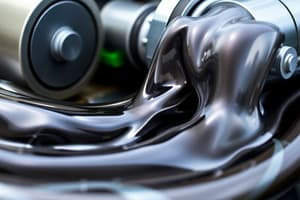Podcast
Questions and Answers
What type of flow is characterized by a Froude number less than 1?
What type of flow is characterized by a Froude number less than 1?
- critical flow
- uniform flow
- subcritical flow (correct)
- supercritical flow
What is the classification of flow based on the Froude number?
What is the classification of flow based on the Froude number?
- steady, unsteady, and uniform flow
- supercritical, subcritical, and uniform flow
- supercritical, subcritical, and critical flow (correct)
- laminar, turbulent, and transitional flow
When does non-uniform flow occur in a channel?
When does non-uniform flow occur in a channel?
- when the flow is uniform and steady
- when the flow is laminar
- when the channel slope is changing
- when there is a change in cross-section or obstruction (correct)
What is the condition for critical flow in open channels?
What is the condition for critical flow in open channels?
What is the term for the flow that has a Froude number greater than 1?
What is the term for the flow that has a Froude number greater than 1?
What is the characteristic of supercritical flow in open channels?
What is the characteristic of supercritical flow in open channels?
What is the primary characteristic of uniform flow in open channels?
What is the primary characteristic of uniform flow in open channels?
What happens when the bottom slope, cross-section shape, and/or cross-section size change in a reach of channel?
What happens when the bottom slope, cross-section shape, and/or cross-section size change in a reach of channel?
What is the classification of non-uniform flow in open channels?
What is the classification of non-uniform flow in open channels?
In which part of the open channel does uniform flow exist?
In which part of the open channel does uniform flow exist?
What happens when the bottom slope, cross-section shape, and size become constant in a downstream reach of channel?
What happens when the bottom slope, cross-section shape, and size become constant in a downstream reach of channel?
What is the main difference between uniform and non-uniform flow?
What is the main difference between uniform and non-uniform flow?
What type of flow occurs when changes in velocity and depth of flow take place over a long distance of the channel?
What type of flow occurs when changes in velocity and depth of flow take place over a long distance of the channel?
What type of flow occurs when changes in velocity and depth of flow occur over a short distance in the channel?
What type of flow occurs when changes in velocity and depth of flow occur over a short distance in the channel?
What type of flow occurs when the flow parameters change with respect to both time and space?
What type of flow occurs when the flow parameters change with respect to both time and space?
What is an example of unsteady non-uniform flow?
What is an example of unsteady non-uniform flow?
What is the purpose of an apron in dam construction?
What is the purpose of an apron in dam construction?
What is the result of a hydraulic jump?
What is the result of a hydraulic jump?
Flashcards are hidden until you start studying
Study Notes
Flow Dynamics and Classification
- Flow with a Froude number less than 1 is classified as subcritical flow, indicating that it is calm and stable.
- Flow classification based on the Froude number includes subcritical (Froude < 1), critical (Froude = 1), and supercritical (Froude > 1).
- Non-uniform flow occurs in a channel when the flow characteristics (such as depth and velocity) change along the length of the channel.
- Critical flow in open channels occurs at a specific depth where the Froude number equals 1, representing a balance between gravitational forces and inertial forces.
Characteristics of Flow Types
- Supercritical flow, indicated by a Froude number greater than 1, is characterized by high velocity and lower depth, often leading to turbulent conditions.
- Uniform flow in open channels is characterized by constant flow parameters (velocity and depth) along the channel length.
Effects of Channel Geometry and Flow Types
- When the bottom slope, cross-section shape, or size changes in a reach of a channel, it creates non-uniform flow, altering the velocity and depth of the flow.
- Non-uniform flow can further be classified into gradually varied flow and rapidly varied flow based on the rate of change of flow parameters.
Flow Characteristics by Location and Geometry
- Uniform flow exists mainly in sections of the open channel where the channel geometry and slope remain constant.
- When the bottom slope, cross-section shape, and size become consistent in a downstream reach of the channel, the flow may stabilize into a uniform flow.
Comparisons and Variabilities in Flow Types
- The main difference between uniform and non-uniform flow lies in the constancy of flow parameters; uniform flow shows no variation, while non-uniform flow demonstrates significant changes.
- Gradually varied flow occurs when changes in velocity and depth take place over a long distance, whereas rapidly varied flow involves swift changes over a short distance.
- Unsteady non-uniform flow refers to flow conditions that vary with both time and space, showcasing dynamic changes in flow properties.
Applications and Results in Hydraulic Engineering
- An example of unsteady non-uniform flow includes flows affected by precipitation events, where the discharge and depth fluctuate over time.
- The purpose of an apron in dam construction is to dissipate energy and prevent erosion of the riverbed downstream from the dam structure.
- A hydraulic jump results in an abrupt change from supercritical flow to subcritical flow, causing turbulence and energy dissipation, typically marked by a rapid increase in flow depth.
Studying That Suits You
Use AI to generate personalized quizzes and flashcards to suit your learning preferences.




